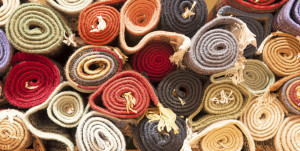Fabric Storage Tips
Carpets, Clothes and Comforters, Oh My! Storing Fabrics 101
When you store your favorite rugs, keepsake clothes and other fabrics, the last thing you want is to worry about mold, insects, dust, and other damage-doers getting to them as they sit. Take a little extra care as you tuck them away for safekeeping to ensure they’re in the exact same shape when you eventually retrieve them.
Remember the 3 Cs:
1) Cleaning fabrics before storing
Clean and thoroughly dry fabric items, or have them dry cleaned, even if they look clean. Bugs can be burrowed out of sight, light stains can set in and darken over time, ground-in dirt can lead to dry rot, and invisible body oils can attract insets and start to smell as they sit.
One caveat: The risks of cleaning heirloom clothing or quilts may outweigh the benefits, so do your research to find your best personal option.
2) Contain (Carefully)
Different items and fabric types call for different specialty measures:
Carpets and rugs should be rolled, to prevent fiber damage and permanent creasing, then wrapped in extra-durable paper, such as waterproof Tyvek—NOT plastic, which can trap moisture. Inspect annually.
Out-of-season clothes are fine in sealed plastic bins or garment bags, as long as they won’t be stored there longer than a few months at a time.
Heirloom clothing and textiles should be individually wrapped in—and possibly also stuffed with—acid-free tissue paper. Contain them in an archival box or cotton garment bag, which resists dust and light but allows airflow. If hanging items, use padded hangers.
Wool, furs and other items made from animal fibers are especially attractive to moths and bugs. Wrap them in cotton fabric, such as a clean sheet, and place them in an airtight bin or bag. This will stop bugs, but also airflow, so remember to periodically air items out. Know that mothballs are extremely toxic, and cedar and herbs aren’t foolproof, plus they lose strength over time.
Quilts and comforters should be rolled, or folded on the diagonal weave of fabric (with crumpled-up acid-free tissue paper tucked into folds), to prevent permanent creasing. Hang in a cloth garment bag, store flat in an acid-free box or wrap in a clean cotton sheet. NOTE: Never store quilts and other fabrics on raw wood, such as inside an unfinished chest, which can stain and weaken fabric.
3) Choose a safe space for fine fabrics
No matter the textile, you want to protect it from light and temperature and humidity extremes, which often means the garage, attic or unfinished basement simply won’t do. Instead, choose safer (aka clean, cool, dark and dry) spots, such as an out-of-the way closet or under the bed.
For ultimate safekeeping, store your fabrics in a climate-controlled EZ Storage unit. These units provide better control of humidity and decrease the presence of dust and bugs.
Contact us for safe and affordable storage solutions for your fabrics and more.



